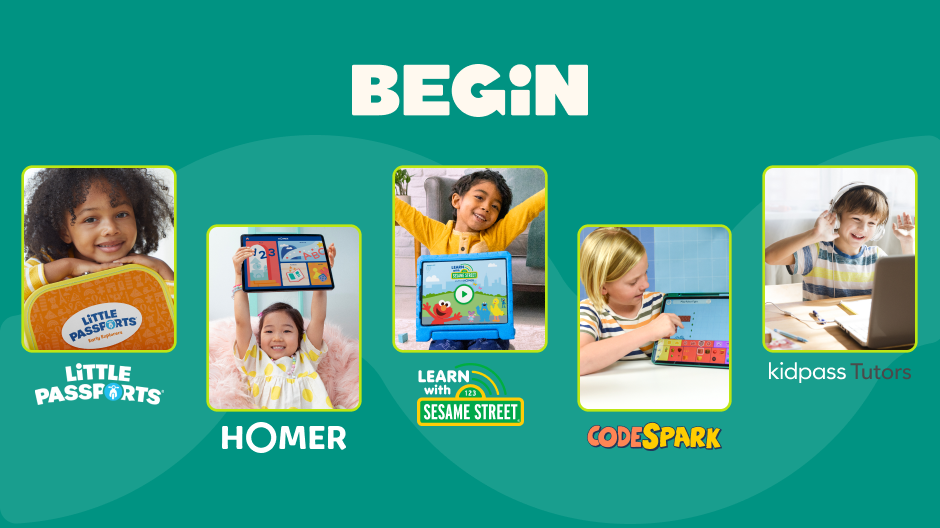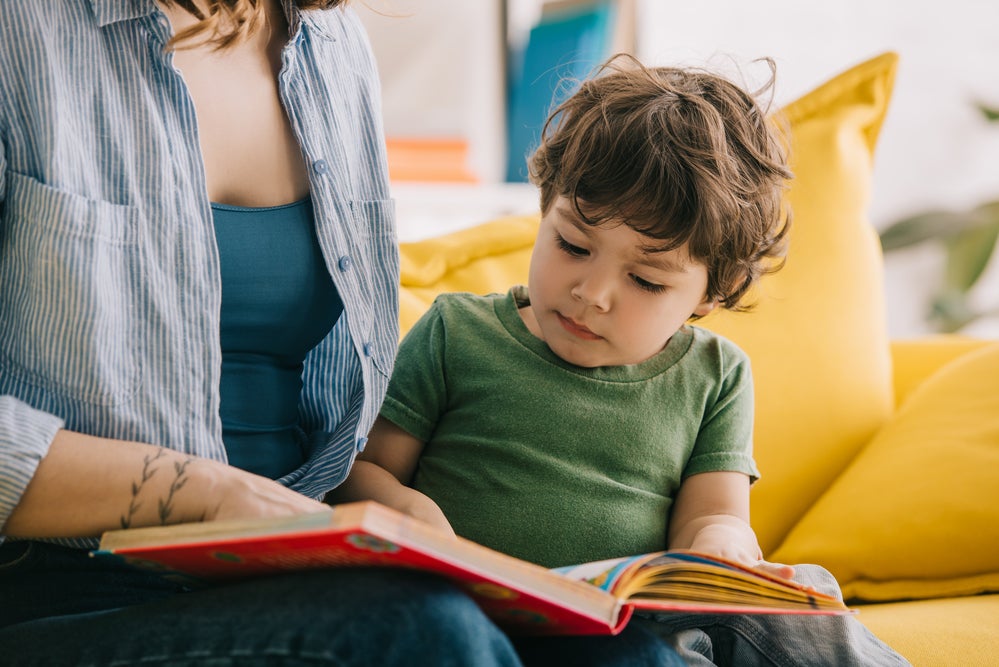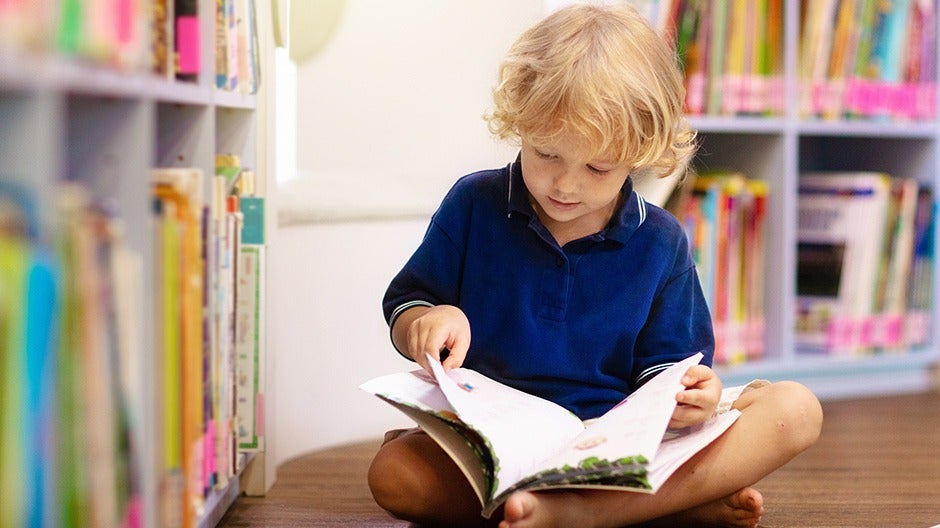When a child finally learns how to construct their own simple sentences, it’s a really special moment for kids (and parents!).
Word combinations such as “knee sore” turn into “Mommy, my knee is sore.” Or “now juice” develops into “Can I have some juice?”
These moments show that kids are developing language-related Core Skills, one of the 5 C’s at the heart of the Begin Approach to helping kids thrive in school and life. Strong Core Skills set up a child for future success in school and work, and they’re as important today as ever.
If you’re wondering how to help your child start constructing their own simple sentences, you’re in the right place. Learn what makes a sentence easy for kids, then try our favorite activities to help with sentence formation.
The Short Cut
- Kids start forming simple two-word sentences between 18–24 months and are usually speaking in full sentences by age 4
- Easy sentences for kids involve a single clause made up of a subject (“Thomas”) and a predicate (“kicks the ball”)
- You can encourage kids to use simple sentences through play! Try having them act out sentences, make up stories, and play games like switching a sentence’s subject
When Do Kids Start Forming Sentences?
Children start forming simple sentences once they know a few words. But language development is quite a journey!
Somewhere between 18 and 24 months, a toddler will begin constructing two-word “sentences,” like “want milk” or “no sleep.” At this stage, they are linking two or more words together to express an idea. This is the first step and a big milestone.
By four years old (sometimes earlier), most children are speaking in complete sentences. But that doesn’t mean they’ve reached the end of their sentence journey.
While your child may be speaking in complete sentences, finding playful ways to expose four- and five-year-olds to sophisticated aspects of language while being age-appropriate is beneficial. This will help them continue developing their language skills.
One of the best ways to do so is to encourage kids to speak in complex sentences to express their ideas. How? By simply resisting the temptation to simplify our own speech.
Remember that children are learning sponges! They will naturally pick up on the language habits you expose them to. So, continue speaking in complex sentences while in their presence. It’s not a bad thing if your child asks, “What does that mean?”
What Makes a Simple Sentence?
A simple sentence is the most basic form of a sentence. It contains only one independent clause—a group of words that forms a complete thought and is made up of a subject and predicate (which includes a verb and expresses what is said about the subject).
For example, in the simple sentence, Thomas kicks the ball, “Thomas” is the simple subject and “kicks the ball” is the predicate, with “kicks” being the verb, or simple predicate.
Simple sentences for kids are mostly short, but they can also be long. The length of the sentence isn’t the focus. What’s important is that the basic elements (subject and predicate) are always present.
When we communicate in our everyday lives, we usually employ a good mixture of both simple and complex sentences without even thinking about it. In order to help our kids reach this effortless communication stage, we need to help them understand the basics.
The good thing about the English language (and every other language, actually!) is that once you understand the basics, moving on to complicated structures becomes easier.
Simple Sentences for Kids to Act Out
One of the best ways for kids to learn is through acting things out. If you have an active young child who enjoys moving around, why not use their energy to encourage some learning?
Here are some simple sentences for kids that they’ll have fun acting out.
- He reads a book.
- The dog barks.
- The cat sits on the mat.
- I hop on one foot.
- The pig gobbles his food.
- The rooster crows.
With these sentences for kids, your child will have a blast while naturally learning what makes up a sentence!
Other Ways to Practice Sentences for Kids
1. Use Pictures
We recommend having your child use pictures to make up stories. You can even record the stories and listen to them later for a little added fun!
If your child wants to write their ideas, too, that’s great! But don’t worry about standard spelling; much more important is the creative effort involved in thinking of a great story composed of interesting sentences of their own creation.
You can use pictures of animals, nature, sports, or even family photos. Then encourage your child to share whatever comes to their mind after having a look at these images.
During the first session, your child may need a few verbal prompts to help them get started. Simple questions like, “What’s happening in the picture?” or “What does this image remind you of?” can help get their creativity flowing.
If you have multiple children, you can allow them to share what they came up with about the same image. They’ll likely think of different sentences, so this is a great opportunity to emphasize how everyone has unique ideas.
We encourage you to allow your children creative freedom here. The idea is to place an image in front of them and let them come up with anything they feel like.
2. Play Sentence Games
If you’ve read many of our parent resources, you’ll know one thing for sure—the Begin team loves a good game! Games are not only fun, but they’re also great ways to help children remember fundamental learning concepts.
One of our favorite sentence games is Sentence Mix & Match.
What You’ll Need
- Several index cards
- Markers to write with
What to Do
- Write interesting subjects on half of the index cards (Ideally, these are things that your child likes. For example: dinosaurs, ice cream, shapes, colors, etc.).
- On the other half, write predicates or sentence endings that make sense with your individual subjects.
- After writing, place the cards so that they make realistic sentences.
- Then, turn all the cards over and shuffle them. At this point, you want to ensure that you separate sentence beginnings and endings.
- After the shuffle, turn your cards over and discover what silly sentences you get.
- Remember to begin the subject cards with capital letters and sentence-endings cards with a period.
This is a fun activity to help children see that sentences are not always set in stone. They will quickly learn that the meaning of a sentence can change when words get moved around.
3. Play with Types of Sentences
Sentence Mix & Match isn’t the only way to help kids learn sentences while also having fun. Another activity we’re huge fans of is playing with types of sentences. Specifically statements, questions, and exclamations.
To get started, pick any simple sentence that your child will already be familiar with (e.g., “I like playing outside.”).
Next, encourage your child to say this same sentence as a statement, a question, and then an exclamation.
Similar to Sentence Mix & Match, this game helps children understand that minor tweaks can change the meaning of a sentence.
Children will come across punctuation marks during reading time, but they may not always understand the significance of each. This game will help your child learn how periods, question marks, and exclamation points affect a sentence.
4. Make a Switch
The subject and predicate for each simple sentence have a specific function. For children to use these correctly, they will need to understand what their roles are.
When kids start speaking as babies and then toddlers, they often repeat words, phrases, or the simple sentences they’ve heard from you, your partner, siblings, or other people around them.
At this stage, they haven’t fully grasped the functions of subjects and predicates. If we want to help our children develop their own sentences, we will need to help them understand the roles of these sentence parts.
A creative game they (and you!) will enjoy involves switching the subjects and predicates of a sentence.
Start with a simple three-word sentence, like, “A cat played.” Then take turns changing either the subject or the predicate of the sentence.
This may look something like this:
- A cat jumped
- A dog jumped
- A dog growled
- A gerbil growled
- A gerbil scampered
Once your young learner is confident switching three-word sentences, move on to four words, five words, and so forth.
Through this fun activity, your child will start understanding the roles of predicates and subjects in sentences.
Simple Sentences for the Win!
A child’s language journey is pretty incredible. It often starts with lots of babbling and moves to single words. Soon, you get two-word combinations, and before you know it, you’re given a detailed account of what happened in class today.
As you’re doing the activities we’ve mentioned, remember to allow your child creative freedom. We know that language has a lot of rules, but that doesn’t mean it can’t be fun! Encourage your young learner to be as imaginative as they want to be.
For instance, if they write or say, “The lion growls at the dinosaur,” celebrate the correct sentence construction and, for a moment, imagine a world where lions and dinosaurs exist in the same age!
Language, Literacy, and Begin

There’s much more to discover when it comes to kids and literacy with Begin. Our free parent resources help make learning easy for you and your family. Our HOMER app can raise early reading scores by 74% with just 15 minutes a day. Or you can check out our Early Learner Program and see how our products come together to give your child their best start to achieving their fullest potential.














